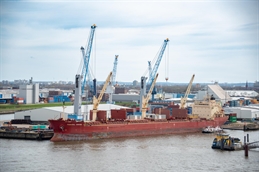
Port of Hamburg said recovery in seaborne cargo throughput could be expected for the remainder of the year after reporting volume decline in the first quarter of 2023 as geopolitical tensions, economic sanctions against Russia and high inflation continued to dampen cargo throughput in European ports.
Germany's "Gateway to the World" and its country's largest seaport by volume said seaborne cargo throughput reached 28.1 million tons in the first quarter of 2023, down 10.2% on the same period of the previous year — but succeeded in maintaining throughput volume at the same level as the final quarter of last year.
Container throughput at 18.6 million tons was 15.9 percent lower than in the same period of the previous year, with the total of 1.9 million TEU being 16.9 percent down.
Rise in bulk cargo handling
"The problematic trend in the world economy is affecting Port of Hamburg throughput figures. As in other ports of Northern Europe, seaborne cargo throughput is falling, yet the trend in certain sea trades is positive," the port said in a statement, notinh that as an all-purpose port, Hamburg is profiting from a rise in bulk cargo handling.
It added that as elsewhere, in the Port of Hamburg seaborne cargo throughput for its terminals is currently subject to a challenging economic environment.
Persistent geopolitical tension, EU economic sanctions against Russia, high inflation, global reluctance to make purchases and massive warehouse stocks are restraining cargo handling in European ports.
Axel Mattern, CEO of HHM — Port of Hamburg Marketing, stressed that "the tough general economic situation is reflected in current throughput figures for all North Range ports."
"Among these competitors, Hamburg lies here in mid-field."
"When comparing quarterly returns for the current and last years, it needs to be remembered that at the beginning of last year, Russia was still the Port of Hamburg's fourth largest trading partner. Sanctions came into force after the invasion of Ukraine, as is noticeable in this comparison — freight volumes to and from Russia are now missing from the general view," Mattern said.
In addition, he noted that the at times unstable economic situation in China on account of the pandemic has continued into this year.
"Neither of these factors were without repercussions on the Port of Hamburg," he added.
Apart from developments in the European and world economies, the occurrence of strikes locally also impacted the Port of Hamburg's annual result.
Meanwhile, Port of Hamburg noted positive developments in North America trades and on bulk cargo handling.
"With handling at 152,000 TEU, up 9.5% on the previous year, the US trades remain a positive feature of seaborne container transport via the Port of Hamburg, with the United States continuing to fill second place after China among the Port of Hamburg's top trading partners," the announcement said.
Meanwhile, it added that with 31.7 percent growth to 52,000 TEUs, trade with Canada also grew robustly.
Up by 5.4% on the same period of last year, at 9.3 million tons the trend was also positive on bulk cargo handling in Hamburg.
Port of Hamburg noted, however, that the best performer was the liquid cargo sector, with an increase of 12.3%.
Imports of oil products rose by 27.4%.
The agribulk sector also grew. Higher exports of grain and feedstuffs, along with higher imports of oleaginous fruits, fuelled an 11.8% growth to 1.8 million tons.
Grab cargo throughput was almost unchanged on the first quarter of the previous year, the port said.
More megamax vessels in Hamburg
Port of Hamburg further reported that the trend for larger containerships to call at the port was also maintained with a 17.5% increase to 67 calls by containerships of the Megamax class, those with capacities of over 18,000 TEUs.
"Many newbuilds ordered by shipowners are now entering service. The first call in Hamburg by the 'OOCL Spain,' with a capacity 24,188 TEU, illustrated this. This persistent trend shows the urgent necessity of securing the water depths essential for an ability once again to eliminate any temporary restriction of water depths on the tidal Elbe," Mattern said.
During the first quarter, 11.6 million tons were transported to and from the hinterland by rail, or 3.4% less than in the same period the previous year.
The downturn in seaborne container throughput caused correspondingly fewer — 10.1 percent — containers (635,00 TEU) to be transported by rail in pre- and on-carriage.
"Primarily for container transport, the first quarter brought difficult operating conditions. Some shipping companies, for instance, cancelled ship calls, while several strikes in March affected port operation in the short term. These factors made it difficult for rail operators to fill their trains," Mattern said.
Positive prospects for the rest of 2023
"For the remainder of the year, a recovery in Port of Hamburg throughput total may be expected," the port said in the statement.
Mattern explained that during the first three months, Port of Hamburg had to report an "extreme underlying trend statistically, with the very distinct difference in the background economic factors in the first quarters of the years 2022 and 2023."
"Multiple crises caused disruption of supply chains and weak economic growth. This has affected throughput," HMM's CEO added.



